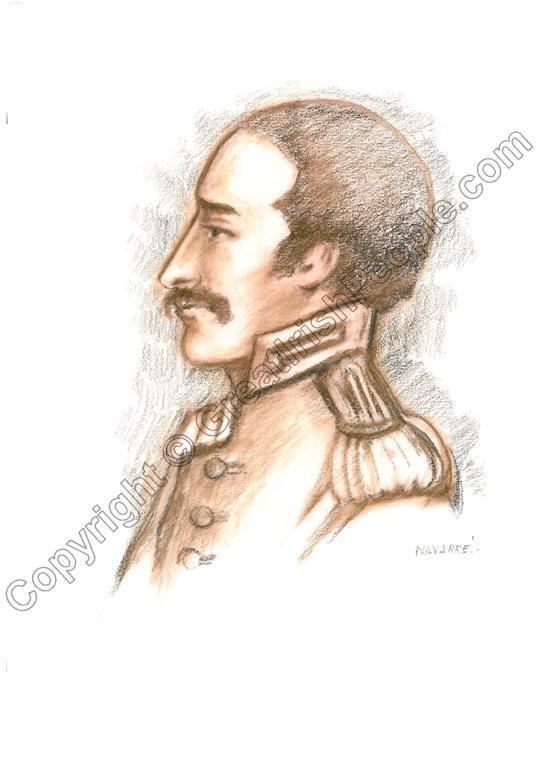Name George Thomas | ||
 | ||
George Thomas, nicknamed Jaharai Jung and Jahazi Sahib, (c. 1756 in Roscrea, Tipperary, Ireland – 22 August 1802 in Berhampur, West Bengal, India) was an Irish mercenary and later a Raja who was active in 18th-century India. From 1798 to 1801, he ruled a small kingdom in India, which he carved out of Hisar and Rohtak districts of Haryana.
Contents
Biography
His father was a poor Catholic tenant farmer near Roscrea who died when George was a child. Originally forced to press-gang at Youghal, where he worked as a labourer on the docks, Thomas deserted from the British Navy at the age of 25 in Madras in 1781. Still illiterate at the age of 32, he led a group of Pindaris north to Delhi by 1787, where he took service under Begum Samru of Sardhana.
Though he was the favourite general of Begum Samru, due to jealous intrigues of his French rival Le Vassoult (committed suicide in 1795) he was supplanted in 1792 in her favour. He then transferred his allegiance to Apa Khande Rao, a Maratha chieftain under Maharaja Mahadaji Scindia (ruled 1768–1794) of Scindia dynasty that ruled Gwalior State. He worked for Apa Khande Rao for four years from 1793 to 1797 to conquer Haryana by subduing Rajputs of Rajasthan, Kachawa Shekhawat thakur rulers of Haryana and Shekhawati, Sikhs misl of Haryana, Mughals under vizir Mirza Najaf Khan and Bhatti Muslim Rajputs.
After 1797, he carved out an independent kingdom in the districts of Rohtak and Hisar and made Hansi as his capital. During his short period of rule, he established a mint in Hansi and released rupees of his own kingdom. His area of control included area from Ghaggar river in the north to Beri in south and from Meham in the east to Bhadra in west. He rebuilt the Asigarh Fort at Hansi, which was in ruined state and built defensive walls and fortifications. He divided his area of control into 14 paraganas.
Historian Jadunath Sarkar (1870–1958) describes his conquests as "Oval in hape, with ill-defined and ever-shifting frontiers, it extended 32 to 48 miles in different directions. On the north lay the Ghaggar river which separates it from the lands under Sikh occupation; the west the country of predatory Bhatti tribes, beyond which lay the deserts of Bikaner. The south was bounded by the Rewari district."
He styled himself as the Raja of Handi and he also liked to introduce himself as Raja from Tipperary. He marched on the kingdoms of Jaipur, Bikaner, Udaipur and Sikhs and mostly emerged victorious.
George told his biographer, William Francklin, "I established my capital, rebuilt the walls long since decayed, and repaired the fortifications (of the 12th century fort of Prithiviraj Chauhan). As it had been long deserted, at first I found difficulty in providing for inhabitants. But by degrees, I selected between five and six thousand persons to whom I allowed every lawful indulgence. I established a mint and coined my own rupees, which I made current in my army and country; as from the commencement of my career at Jhajhar I had resolved to establish independence. I employed workmen and artificers of all kinds. I cast my own artillery, commenced making muskets, matchlocks and powder and in short, made the best preparations for carrying on an offensive and defensive war."
Between 1798 and 1801, he built Jahaj Kothi (c. 1796) and Jahaj Pul at Hisar, Haryana which was his residence, which was also used by James Skinner after George's defeat. He ruled the area independently up to 1801, when he was driven out by Sikh-Maratha-French confederacy. He was finally defeated and captured by Daulat Rao Sindhia's army under General Pierre Cuillier-Perron.
James Skinner, while serving Maratha, had earlier fought against George Thomas. After George's defeat, Skinner lived at Jahaj kothi in Hisar, Skinner himself died at Hansi (in Hisar district, Haryana), on 4 December 1841, at the age of 64.
Death
He died, at Baharampur near Murshidabad in West Bengal, of a fever on board his boat on his way to Kolkatta down the Ganges river on 22 August 1802. He is buried in a grave at Baharampur.
Legacy
The Jahan Kothi and Jahaj Pul suburb in Hisar of Haryana state in India are named after him.
George met his biographer William Francklin on the way to Berhampur shortly before his death, and narrated his exploits to William, who published George's biography "Military memoirs of George Thomas" in 1805, based on direct interaction and original documents.
